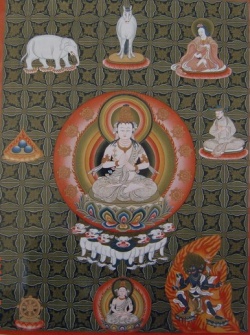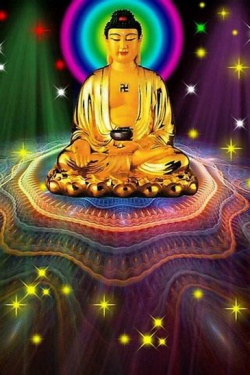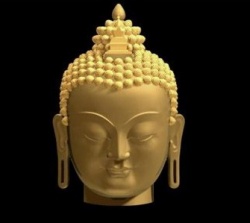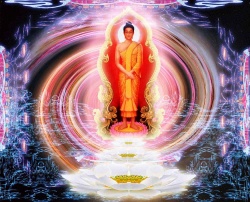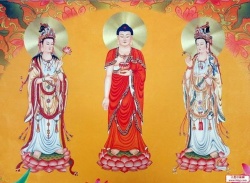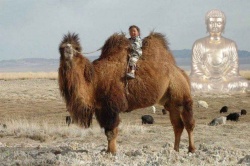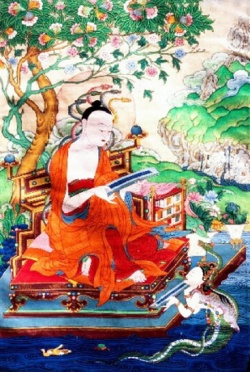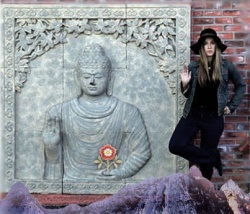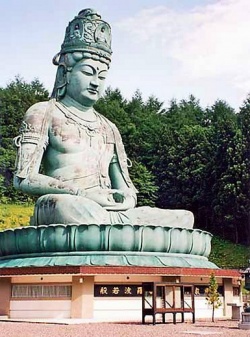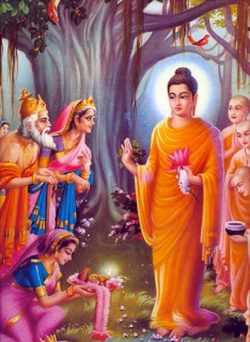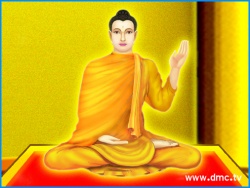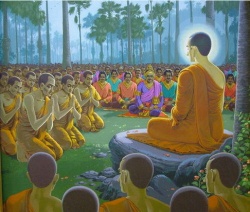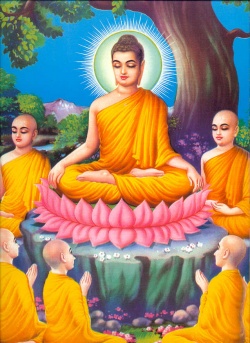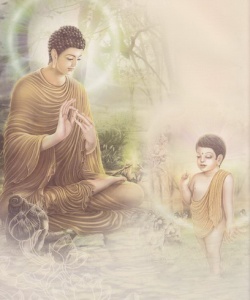Manual of Abhidharma - Reading Six: How Emptiness Allows Karma to Work, According to the Middle-Way School
The following selections are from the Overview of the Middle Way, composed by Master Kedrup Tenpa Dargye (1493-1568).
Let us first consider enemy destroyers of the Listener or Self-Made Buddha type. Aren’t you saying then that, like the non-Buddhists, they fail to eliminate all the widespread mental afflictions that operate in all three realms? Because isn’t it true that they have failed to achieve the path which is directly incompatible, in the way it holds its object, with the root of all these afflictions; that is, the tendency to conceive of things as existing through some nature of their own? And this is true, for they lack that comprehensive knowledge where they realize that things have no nature of their own.
Consider these same enemy destroyers. It is true that they have not yet realized, entirely, the fact that the person has no self nature. This is because they have yet to perceive directly the fact that the person has no nature. This in itself is true as well, for they are still chained by total misperceptions, in such a way that they will never be able to root out the object that they think they see when they hold the parts to the person, the thing which gets the label of “me,” as existing from its own side. And this too is true, for they lack that comprehensive knowledge where they realize that the parts to the person have no nature of their own.
The first of our logical statements above is always true. For suppose that a person is still unable to root out the object that he thinks he sees when he holds the parts to the person, the thing which gets the label of “me,” as existing through some nature of its own. As long as he goes on this way, then he will continue to find himself unable to root out the object that he thinks he sees when he holds the thing which gets the label, the “me,” as existing from its own side. And as long as he continues with this, then by the power of this misperception he will continue to collect karma. And as long as he collects karma, then he will continue to spin around in this wheel of suffering life.
This then is the ultimate idea within the root text and the commentary of the Higher Line, [written by Maitreya and Asanga):
Due to the mental seeds for the two kinds of tendencies to grasp to some selfnature, these two tendencies themselves spring up.
Due to the fact that they have sprung up, an impression with a wrong way of looking at things springs up, and some things seem as though they are pleasant from their own side, and other things seem as though they are unpleasant from their own side.
Due to the fact that this impression has sprung up, the emotion of liking springs up, where you focus on a pleasant object and don’t want to lose it. And the emotion of disliking springs up, where you focus on an unpleasant object and want to avoid it.
This then forces you to collect karma.
And karma forces you to spin around in the wheel of suffering life. And this is why the Buddhas have said that this suffering life is something forced on us because we have not been able to see, directly, the essence of the Ones Gone Thus [that is, emptiness).
Here we will analyze the statement [from Entering the Middle Way, by Master Chandrakirti (650 AD)] where it says, “…The mind of a craving spirit as well, which sees a stream of water as pus.” One may begin with the following question:
Let’s consider the objects of the following states of mind: the visual consciousness of a craving spirit where a river of water looks like pus and blood; the visual consciousness of a person with a kind of cataract where a clean white porcelain basin looks like a hair has fallen into it; and that kind of meditation where you visualize skeletons—where you imagine that the entire surface of the earth is covered with the bones of corpses. Are all these objects completely equivalent, as far as being something that exists or doesn’t exist?
In reply we will first set forth a relevant passage, and then we will explicate the passage. Here is the first. The text called The Abbreviation of the Greater Way says,
Insofar as craving spirits, animals,
Humans, and pleasure beings, each according
To their class, have differing perceptions
Of a single thing, we say it has no reality.
Asvabhava, the venered layman with lifetime vows, has explained the passage. His words include the following:
When they look at a single thing, a stream of water, each one sees what the ripening of his particular karma forces him to see. A craving spirit sees the river full of pus and blood and the like. An animal or such, on the other hand, thinks of this same water as a place to stay, and makes his home there.
Humans look at the same thing and perceive it as water—sweet, clear, and cool. They drink of it, they wash themselves with it, and they swim in it.
Those pleasure beings who are wrapped in deep meditation at the level we call the “realm of limitless space” see the water as empty space, for their ability to conceptualize physical matter has dissolved altogether.
Here secondly we will explain the meaning of the text we quoted first. We proceed in three steps: disproving the position of others, establishing our own position, and then refuting their rebuttal. Here is the first.
Someone may make the following claim: Given the statements that have come above, the fact is that we should never again consider anything as being one way or the other.
Well then, you must be suggesting that the system of the Buddha is all the same as the system of every non-Buddhist belief, that there is no difference in their correctness at all. And you must be saying too that we could never state that our Teacher was the highest teacher, and that the teachers of the non- Buddhists are lesser.
And you must be suggesting all this, for you have claimed that we should never again consider anything as being one way or the other.
Now if you should agree that none of the differences mentioned above exist, we must reply that they do, for as the verse says:
All other teachers now I’ve given up,
And go for refuge now to only You;
Why? Because it’s You alone who has
No fault, and perfected every good.
Someone else might make the following claim: Suppose a pleasure being, a human, and a craving spirit sit down together and look at a glass filled with water: the thing that we define as “wet and flowing.” Since to the perceptions of each different type of being it is real, the glass full of wet and flowing water is in reality pus and blood to the eyes of the craving spirit, and in reality water to the eyes of the human, and in reality ambrosia to the eyes of the pleasure being.
We ask you then a question: in the situation you’ve just described, is it that the visual consciousness of all three beings are a valid perception, or is it that only one or two of them are a valid perception? Suppose you say all three are valid. Well then, the glass of wet and flowing water must be full of something that is all three different things: pus and blood, and each of the others. And then too it must be possible for there to be multiple and yet still valid perceptions which see one thing in two completely incompatible ways. And finally there must be such a thing as a valid perception which correctly perceives that the glass is filled with something which is simultaneously water and yet not water. Why so? Because, according to your view, the three differing cases of visual consciousness possessed by the three different beings would all have to be valid perception.
And if you try to agree to these absurdities, you are wrong, for the quality of being pus and blood is incompatible with the quality of being either one of the other two substances mentioned. Moreover, the quality of being water and the quality of not being water are directly incompatible in such a way that, if something exists and lacks one of these qualities, it must then possess the other.
Someone may answer with the following claim: In the case mentioned, the visual consciousness of the human is a valid perception, but the visual consciousnesses of the other two types of beings are not valid perception. These latter two see something like the pus and blood, and the ambrosia, only because their karma (which is good in one case, and bad in the other) forces them to.
Well then, according to you, the visual consciousness of the human wouldn’t be valid perception either. Because isn’t it true that the human sees the water only because his karma (which in this case is halfway between the good and the bad just mentioned) forces him to? Moreover, aren’t you implying then that there is no such thing as a valid tactile consciousness, or a valid auditory consciousness, in the mental stream of any being who is not a human? Because aren’t you saying that there’s no such thing as a valid visual consciousness in the mental stream of any such being? Certainly you are, for you believe your original position to be correct. And suppose now that you do agree that such beings can have no such valid consciousnesses.
Aren’t you then implying that these beings never have any case where they are able to reach a definite conclusion about something, or to analyze an object? And if so, aren’t you implying that there could never be a case where one of these beings could recognize another? Of course you are, given your position. Here secondly is the section where we establish our own position. Now suppose three different types of beings—a pleasure being, a human, and a craving spirit, each with their own karma—sit down together and look upon a glass filled with water, the thing we define as “wet and flowing.” The glass of water is not at this point one thing which is simultaneously three different objects. Neither is it necessary in this situation for there to be three identical valid perceptions. And when the glass full of wet and flowing water occurs, it occurs with three different, distinct parts to it.
It is not though the case that, from the time it first started, the glass of water came with the three different parts, or that they stay with the glass of water until it eventually ends. What happens is that one of the parts of the glass filled with wet and flowing water provides a material cause, and the karma of the craving spirit provides a contributing factor; and then based on both of these the later continuation of one part of the glass of water starts being blood and pus.
Another part of the glass of water again provides a material cause, and the karma of the human provides a contributing factor; and then based on both of these the later continuation of one part of the glass of water starts being water. Yet another part of the glass of water provides a material cause, and the karma of the pleasure being provides a contributing factor; and then based on both of these the later continuation of one part of the glass of water starts being ambrosia, and so on.
At this point, the glass full of wet and flowing water is something with three different parts. Nonetheless, it is not the case that all three different beings see all three parts. The craving spirit is forced by the bad karma he has collected to see the glass of water as pus and blood; and he doesn’t see the other two things. One should understand that a similar case holds with the latter two types of beings.
What we just described as happening is only with reference to where a glass of something wet and flowing is an object shared by the three different beings, as they look at it together. When the craving spirit himself though picks up the glass in his hand and begins to partake of its contents, the glass of liquid is no longer something that exists with three different parts. Since at this point it is something that the craving spirit is experiencing exclusively, its continuation starts being pus and blood.
How the glass of liquid exists originally all depends on the particular outer world from where it has been taken, for each of the three different beings has a different outer world, depending on the specific karma he himself has collected. If the glass of liquid were sweet, cool water taken from the world of humans—a world created by the specific karma of the human in the group—then that would be its original condition, and so on.
When we say that a craving spirit looks at a stream of water and sees pus and blood, by the way, we are only talking about some kinds of craving spirits, and not all of them. This is because there are many kinds of craving spirits: some with obstacles in the world around them that prevent them from relieving their craving; some with obstacles that are parts of their bodies; and some with obstacles that relate to the food or drink itself.
There is, moreover, an example we can use for how, when the three different types of beings with their three karmas look all together at a glass full of something wet and flowing, there start to be three different objects, each confirmed by a valid perception. Suppose there is a ball of red-hot steel; one piece of this ball provides the material cause, and the “mantra of steel” provides a contributing factor. Due to these two, a person who has used the mantra of steel on his hand can touch the ball, but he doesn’t undergo any sensation of heat; instead, he feels some other sensation. A person who has not used the mantra on his hand touches the ball and does feel a sensation of heat, and no other kind of sensation.
Another example would be the moon in springtime; one part of the feel of its rays on the body provides the material cause, and then the karma of a craving spirit provides a contributing factor. Based on these two, the spirit gets a sensation of heat, which is experienced by the consciousness of the body. So too with the wintertime sun; one part of the feel of its rays on the body provides the material cause, and then the karma of the craving spirit provides a contributing factor. Based on these two, the spirit gets a sensation of cold, which is experienced by the consciousness of the body.
It is a fact that they get this kind of sensation, for (Arya Nagarjuna's) Letter to a Friend states:
For craving spirits, even the light of the moon
In the spring is hot, and even the winter sun cold.
All of this is caused by the extraordinary circumstances of the particular time and place, for generally speaking it never happens this way: there is nothing at all about the sun that can feel cold, and nothing about the moon that can feel hot. This too is a fact, for there does not exist on the sun any case of that substance we call “covered space.”
Here is the third part of our presentation, where we refute the rebuttal of representatives of other views. You will recall that our own position is describing a situation where beings of three different types, each with their own karma, are sitting together and looking at a glass filled with something that is wet and flowing. The glass filled with something wet and flowing exists, at this point, as something with three distinct parts. Nonetheless, no one of the beings is able to see all three things there, for they are each at the mercy of the particular karma that they themselves have collected. Representatives of other viewpoints now come to attack this position.
One comes and makes the following claim:
Your position, as just explained, is mistaken, for it goes against a statement of the glorious Dharmakirti. This is quite surely the case, for in his major work [entitled The Commentary on Valid Perception) he says, Suppose you say that they don’t see it, And circumstances cause another form.
What he’s talking about here is a belief of the [non- Buddhist) Numerist School. They give the case of a single person whose physical form is looked upon at the same time by his enemy, and also by his friend. In reality, the person’s physical form is both attractive and ugly at the same time. Something happens where yet another physical form, one from karma, grows up between the person’s true physical form and the enemy and friend looking at it. Because of this neither the enemy nor the friend sees both the attractiveness and the ugliness together.
Master Dharmakirti uses logic to refute this concept, and this same logic can be used against the position you have taken, to prove that you are wrong.
Your reasoning here is though incorrect, for the belief you have expressed shows that you have failed to understand both the meaning of Master Dharmakirti’s statement, and the whole position expressed above.
This is a fact, for the actual meaning of Master Dharmakirti’s statement is as follows. The Numerist School is describing a situation where you are looking at a physical form either from far away, or from up close. They say that, depending on the distance between you and the object, another physical form which is the result of karma, and which stands between your visual consciousness and the original form, is either clear or not. This then determines whether the original form appears to you distinctly or not. It is not the case though, they say, that what determines whether the original form appears clearly or not is whether or not you have a clear impression of this form.
In reply then Master Dharmakirti is asking the Numerists:
Let’s consider these two cases of some intermediate physical form that comes from karma. Do they, or do they not, function to obscure the two original forms, the one at a distance, and the other close by? If they were to obscure them, then your visual consciousness could never see the two original forms, since they would have been obscured by the others.
And suppose you say that they do not obscure them. Wouldn’t your visual consciousness then see both the two intermediate forms created by karma, and the two original forms, the near one and the far one, all at the same time? They would have to because, according to you, the intermediate forms do not obscure the original ones.
This is the real point of the Master’s statement, wherein he refutes that belief of the Numerists.
Our second point [that you have failed to comprehend the position we expressed above] is also quite true. Our original position was describing a situation where three different kinds of beings were sitting together and looking at a glass full of something wet and flowing. It is not our position that the glass full of something wet and flowing is one thing that is three different things. And it is not our position that there is such a thing as the physical appearance of a person which is at once both attractive and ugly.
It is furthermore not our position that the blood and pus represent some kind of physical form which results from karma and grows up between the visual consciousness of the craving spirit and the stream of water. And it is not our position that the craving spirit’s eyes see both this blood and pus as some kind of physical form resulting from karma, and the river of water at the same time. It is our position that, by force of his karma, the craving spirit is not able to see the stream of water.
And anyway, maybe it’s you who have contradicted a statement of the glorious Dharmakirti. You have taken the position that the five sicknesses, and the five elements, and the five demons are all the direct result of the five poisons—the five bad thoughts. But when the non-Buddhists take the position that phlegm and desire have a cause-and-effect relationship, and that bile and anger have the same kind of relationship, and so on, then Master Dharmakirti refutes them by showing that desire doesn’t always come and go according to the phlegm, and anger doesn’t always come and go according to the bile. To do so he makes the statement that says, “It’s not a fact that wind and the rest are such, for the relationship doesn’t always hold.” We could twist around this statement too and say that it disproved your position; and add as well how wrong it is to assert that uncreated space could ever be the direct result of jealousy.
[The point seems to be that, although your position about the bad thoughts, and our original position on the nature of the three beings' perceptions, are both correct, you could always twist around some quotation by a master, take it out of context or misinterpret it, and try to show they were wrong.]
Someone else might come and make yet another claim: Let’s talk about that quotation above, where it said:
Insofar as [these different beings) have differing perceptions
Of a single thing, we say it has no reality.
The idea being expressed here is that a single object can be appearing in three different ways. This is incorrect because, according to you, what’s happening is that three different objects are appearing in three different ways. And this certainly is your position; remember, you were describing a situation where three different kinds of beings sit down together and look at a glass full of something that’s wet and flowing. You said that there were three different objects, each confirmed by a valid perception, and that they were appearing in three different ways.
Well now, suppose a person is using all four of his limbs, and his head, to perform five different actions. According to you, it wouldn’t be one person performing five different actions, because five different protuberances of his body are performing five different actions.
In response to this line of reasoning, someone responds:
No, there’s no such problem here. The five protuberances are all parts of the one person, so we have to say that, when the five are performing some actions, the person is performing some actions.
Well the case above is exactly the same! The three things mentioned, the blood and pus and the other two, are all parts of the glass full of something wet and flowing. When the three appear then we can say that the glass full of a thing which is wet and flowing is acting as a basis, and that three different ways of appearing are being displayed upon it.
Someone else may come now and make yet another argument:
Let’s talk about these three things: the pus and blood, and the other two. Are you implying then that these are not types of objects which would block each other from entering the space that each one occupies? After all, you were talking about a situation where those three types of beings, each with their own karma, sit down together and look at a glass full of water. And you said that your position was that it was possible for there to be three different objects there, each one confirmed by a valid perception.
This kind of reasoning, where you attempt to show that we are implying that the three objects are not the kinds that block each other from entering the space that each one occupies, cannot disprove our position. It is not our belief that in this situation the glass full of something which is wet and flowing is one thing which is three different things. Neither did we ever say that there definitely had to be identical valid perceptions here.
Someone might make the following claim:
In his Commentary to the Twenty Verses, Master Vinitadeva makes this statement—
If there was not a single drop of pus there, then how could there ever be a whole river of pus? They are forced to see it, through the ripening of their karma.
According to you, this statement would have to be mistaken, because when the three different kinds of beings sit down together and look at the glass full of something wet and flowing, the visual consciousness of the craving spirit is a valid perception, and the pus is real pus.
And yet there is no such problem. No matter how many arguments of this kind you want to present, they are all made from the point of view of denying the existence of external objects. The way these arguments go is as follows. If the color blue were to exist as an external object, then the following would occur when this color appeared directly to a sense perception grasping blue; that is, with such a perception found in the mental stream of one of those who “only sees this side” [which is another name for those who have not yet perceived emptiness directly].
When an earlier instance of the perception of blue ends, what actually happens is that it plants a mental seed which eventually grows into a later instance of the same perception of blue, when the seed ripens. Suppose the blue were not just this kind of appearance, but rather an appearance where blue as an outer object were transmitting a likeness of itself and thereby appearing to one’s perceptions. Something else then would be happening when the three different beings sit down together and look at the glass full of something wet and flowing. The three different objects would be appearing to them because each of the objects was transmitting a likeness of itself to their perception. All of this would be happening independent of any process where each being’s karma planted a mental seed, which later ripened and produced the appearance of the object.
If this were how the three objects were appearing, then they would not be appearing through a process where the specific and different karma that each of the three beings had collected had planted a seed in their mind which later ripened. As such each of the beings involved would have to be perceiving all three of the objects, whereas the fact is that they do not. All this is an argument attempting to refute those who refuse to accept the denial of outer objects.
The real meaning of the quotation by Master Vinitadeva is therefore the following:
Suppose there didn’t exist a single drop of pus that existed as it appeared to exist to the craving spirit; that is, which existed as an outer object. How then could there exist a whole river full of pus which existed as an outer object? These beings do though see the pus and so on, for they are forced to do so by their karma.
And this is certainly the case, for later on in the text someone argues that, if the pus and blood did not exist as outer objects, and if they were only a part of the mind itself, then they could never provide the function of being something to eat or drink. And in response, Master Vinitadeva says “Actions and their objects are like an injury in a dream.” He is saying that, even though the pus and blood do not exist as outer objects, nonetheless they can perform the function of being something to eat or drink. He proves his point by using a great many examples, such as a dream.
If this were not the case, then one would have to say that form and other such doorways through which perceptions grow do not even exist at all. Why? Because you would be saying that all the sutras which state that they exist are sutras which do not mean what they say; sutras which you have to interpret to understand their true meaning. And this too is certainly the case, for the autocommentary to the Twenty Verses states that:
In the same way, statements by the victorious Buddha where He says that form and other such doors of perception do exist would be examples of His word that must be interpreted to establish their real meaning; statements that are only spoken figuratively, for the benefit of disciples who might require such explanations.
In response to this someone might claim:
There’s no problem; the point of this statement is to say that sutras which explain form and similar doors of perception as actually existing as outer objects are only spoken figuratively, and must be interpreted to establish their true meaning.
Well then, the meaning of the original statement then is just the same: it is saying that “there does not exist even a drop of pus and blood which exists as an outer object.”
Yet again, another argument might be made:
Let’s take the case of one of those craving spirits that looks at a river of water, and sees it as a dry riverbed, genuinely so. Or consider one that looks at a tree loaded with fruit, but sees it as nothing but bare limbs, genuinely so. The visual consciousness of both of these beings then must be a valid perception. Why? Remember the case of the three different beings looking at a glass full of something wet and flowing; according to you, the pus and blood was actual pus and blood, and the perception of them by the craving spirit was genuine: his visual consciousness was a valid perception.
Just because we said that about the other case doesn’t mean that it’s true in every case. If the craving spirit hadn’t seen any water in that area in the first place, it wouldn’t have made any sense for him to go over in that direction to try to enjoy some of the water. Therefore what happened was that, at first, he saw some water. Later on, he was forced by his karma to stop seeing water and saw only bare, parched earth. Then he had an impression where he thought the water had dried up.
The case with the fruit tree is the same. Although at first the craving spirit sees a tree loaded with fruit, later on his karma forces him to stop seeing fruit, and all he sees is bare branches. Then he has an impression where he thinks that the tree has no fruit any more.
When all this is happening, the obstacle in the visual consciousness of the craving spirit prevents him from seeing the river of water, and so he sees a dry, parched riverbed. The same is true for the visual consciousness of a human: if the obstacle were there, it would prevent him from seeing the river of water, and then he would have to see a dry, parched riverbed.
From one point of view, the river of water hasn’t dried up when the craving spirit looks at it; but there is a river which has dried up, if you’re talking about a river of water that the spirit can see, or a river of water that the spirit can drink from. This follows because when the three different types of beings sit down together and look at a glass full of something wet and flowing, it is true that, due to the force of karma, three different kinds of objects exist there at the same time: the pus and blood, and the other two.
Given all this, consider craving spirits that have obstacles that relate to their food and drink itself. The food and drink there really is food and drink, until such time as the spirit starts trying to eat or drink it. When he does try to do so, then the continuum of the food into the next moment starts becoming pus and blood. It is not though that it is the simple appearance of something as pus and blood that could ever function as something to eat or drink. If this were the case, then the rules of karma and its consequences would have to be less that what they really are. And this is true, for if a craving spirit like this ever existed it would represent a failure of the laws of karma and its consequences.
Suppose moreover that there were no pus and blood out there to appear as the pus and blood, and suppose that the mere appearance of something looking like pus and blood could ever function as something to eat or drink. Well then, you would also have to be able to use a comb on the hair that appears on a porcelain sink to a person with cataracts. And a horsefly that appeared to the same person would have to be able to give him a bite. And the water of a mirage would have to provide all the normal functions of water, and so on. Why so? Well because, according to you, there is no pus and blood out there to appear as pus and blood; according to you, the mere appearance of something looking like pus and blood can provide all the functions of things that you eat and drink.
And consider again this case where a pleasure being and a human and a craving spirit and an animal or the like all sit down together and look at a glass full of something wet and flowing. According to you, it would have to be genuine when something that just looked like ambrosia appeared to the pleasure being, and it would have to be genuine when something that just looked like pus and blood appeared to the craving spirit, but there couldn’t be any pus and blood out there to appear as pus and blood. And if this were the case, then consider the visual consciousness of a being in the hells. It would then have to be a valid perception towards something appearing to it that just looked like the burning steel of the hells, and towards something that just looked like the forest of swords, and towards something that just looked like a mass of fire, and so on. Finally, this person would not have any valid perceptions at all towards any of these things as actual objects. Why would this all have to be so? If your idea were correct, it would have to be, for the logic here is identical to your own.
And suppose you agree that this hell being could have no valid perceptions of the type we mentioned. Well then, the burning steel and other objects could never perform any real actions: they could never burn the bodies of the people born there, they could never chop them up, and so on. Why? Well because of what you just agreed to. And suppose you agree to this; that they could never perform any real actions. Well then, the torment of the hells itself then must not even exist, by your own admission. And remember too that case where the beings all sit down and look at the same thing. You must be saying then that the actual water, the thing towards which the visual consciousness of the human is a valid perception, doesn’t exist at all. Why? Well because, according to you, no actual pus and blood exists either in the same situation. Someone might now make the following claim:
In this situation, there does exist some real water there. This is because the human can confirm the water with his own experience, as it performs all the functions of water—as he uses it to wash himself, or as he uses it to cook something.
Well then, in the same situation there must exist some real pus and blood there as well, because in this same situation the craving spirit can confirm the pus and blood with his own experience as they perform their functions—as he drinks them, and then as the sizzle in his throat and stomach, and so on. Someone may respond to this argument with the following claim: The two cases are not the same. When all this happens to the craving spirit, it’s nothing more than his own imagination.
Well then, what happens to the human can’t be happening to him either, because it’s nothing more than his imagination.
Someone may respond to this with another claim: When the human washes himself with the water and so on, it must not be something real, because it’s nothing more than his own imagination.
Are you saying then that when the pus and blood sizzle in the stomach of the craving spirit, and so on, it can’t be something real? For that too is nothing more than his own imagination. You agree? Well then, the suffering of craving spirits must not exist at all.
Someone might make the following claim:
Isn’t it true that when all those beings sit down together and look at something, there isn’t any actual pus and blood at all? Because isn’t it true first of all that, when a person with cataracts looks into a porcelain basin, there is no strand of hair in the basin at all? And, secondly, doesn’t (Master Dharmakirti's) text itself say,
Identical to the case of someone where his sense power has a cataract,
Is the mind of a craving spirit as well, which sees a stream of water as pus.
And yet there is no such problem, for this quotation appears in the section where we are examining the question of whether, in the schools of the Middle Way and the Mind-Only, an object and the perception of it must be equivalent in either both existing or both not existing. Moreover, there is another fact about this situation, where the stream of water appears as pus and blood to the visual consciousness of the craving spirit. It is no inconsistency to say that the visual consciousness that sees things this way is not a valid perception, and to say at the same time that—when the craving spirit looks at the stream of water—there does exist there actual pus and blood.
Someone again may come and claim the following:
Let’s consider once more this situation where three different types of beings sit down together and look at a glass full of something wet and flowing. Isn’t it true that there is no actual pus and blood there? Because isn’t it true that the burning steel and so on in the hells is only something that appears to a person who is born there, but that there is nothing there which actually is these objects? Because isn’t it true that there is no one at all who went and made all these kinds of things? And isn’t this a fact, because doesn’t the text of The Bodhisattva’s Way of Life say:
Who made the burning steel that acts
As the floor of the world of hell?
Where did all the mass of flames
You find there all come from?
The Able Ones have spoken that
Everything there like this
Is nothing at all other than
The mind of what’s non-virtue.
Yet there is no such problem. The point of this quotation is to say that the burning steel and so on are not something that was created by some unchanging creator being or something like that; by someone who thought it over first and then created them. The lines are meant to show us that what really made all these things is the non-virtuous states of mind had by the beings who have to take birth there.
If this were not the case, then consider those holy people who lead their lives following the ten virtues, and who are then born into the higher realms, and then experience the pleasures of these realms. And consider too those miserable people who lead their lives following the ten non-virtues, and who are then born into the lower realms, and then experience the sufferings of these realms. Is the difference between them just that they are having some better or worse kind of misperception, and not whether they are experiencing pleasure or pain? This would have to be the case, if your reasoning were correct.
Suppose you agree that it is only a matter of better or worse misperceptions. Are you saying then that the pleasures of the higher realms don’t even exist, and that the pains of the lower realms don’t even exist? You must be, if you agree this way.
In conclusion now, let us consider again these three kinds of beings, each with their different karma, as they sit down together and look at a glass full of something wet and flowing. It’s not necessarily true that they must all have valid perceptions which are identical. If they did, then the three beings looking at the glass of water would have to think of the water as a place to live, in the way that a creature living in water would. The three beings as well would have to see the water in the same way that microscopic organisms living in the water, little beings imperceptible to normal visual consciousness, see it with their own visual consciousness. Then too the visual consciousness of microscopic organisms living in the depths of the ocean would have to be a valid perception towards the entire extent of the sea. And certain kinds of near-gods too would have to see weapons as glasses of water, and on and on; the problems raised would be many.
Again consider this same situation. Even though it is not necessarily true that the valid perceptions are identical, it is possible for there to be three valid perceptions here which happen to be identical. This is because, as we have already established logically, there can be a case where by the force of karma three different objects, each one confirmed by a valid perception, start to exist. And since this is possible, then it is equally possible that, by the force of karma, three equivalent valid perceptions of a vessel could start to exist as well.
Generally speaking, each of the three objects mentioned—the pus and the other two—are things of the type that block other objects from entering into the space which they themselves occupy. It is no contradiction though to say that, in this situation where the beings are looking this way, they are not objects such that they block other things from entering into the space they occupy. This is true for the following reason.
A central mountain of the world which is square in shape, and a central mountain of the world which is round in shape, and the like, are objects such that they block other things from entering the space they occupy. Nevertheless, it is possible for both these things to occupy the space taken up by a single central mountain of the world. A red-hot ball of steel is something that’s hot, but consider what happens when a person touches it after he has used the mantra of steel on his hand. The sensation that he feels is not a sensation of heat; on the contrary, it is a sensation of something not heat. [This concludes the section of the text entitled "The Stream."]
See also
- Manual of Abhidharma - Reading One: Introduction to Abhidharma
- Manual of Abhidharma - Reading Two: The Nature of Karma, and What it Produces; the Detailist Concept of ''Non-Communicating Form''
- Manual of Abhidharma - Reading Three: Types of Deeds, and the Nature of Motivation
- Manual of Abhidharma - Reading Four: The Correlation of Deeds and Their Results
- Manual of Abhidharma - Reading Five: How Karma is Carried, According to the Mind- Only School
- Manual of Abhidharma - Reading Six: How Emptiness Allows Karma to Work, According to the Middle-Way School
- Manual of Abhidharma - Reading Seven: Black and White Deeds, the “Path of Action,” and the Root and Branch Non-Virtues
- Manual of Abhidharma - Reading Eight: Most Basic Virtue, and the Projecting and Finishing Energy of Deeds
- Manual of Abhidharma - Reading Nine: The Five Immediate Misdeeds, and the Concept of a Schism
- Manual of Abhidharma - Reading Ten: The Relative Severity of Deeds and What Causes It
- Manual of Abhidharma - Additions Part 1
- Manual of Abhidharma - Additions Part 2

